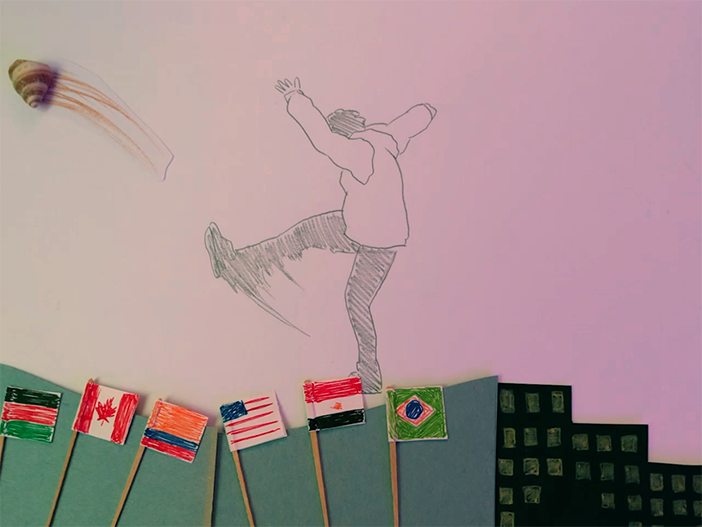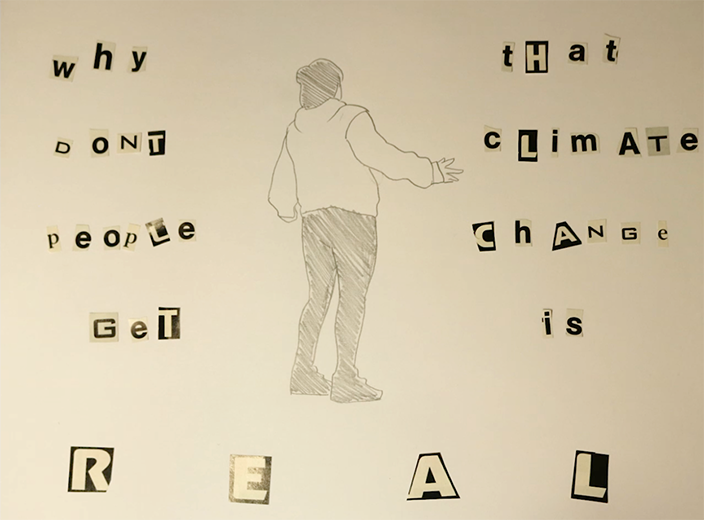In winter, 2021, I and my co-faculty, Laurie Meeker, assigned our students to produce Animated Intergenerational Interviews about individuals’ relationships with their environment. The interviews were to be 30 to 60 seconds long, include at least 30 seconds of animation with 15 seconds in tight sync and make use of animation techniques students hadn’t tried before. Subjects had to be at least 16 years older or younger than the interviewer, pushing students to work across significant differences, which, in this case, amounted to generational divides. Key to this design problem was the combination of nonfiction and the creative treatment of it, echoing Grierson’s definition of documentary. In this post, I will describe some of the creative responses students made and how those approaches amplified what interviewees said.
In the fall, students developed a palette of visual communication skills, completing exercises in drawn and cut-out animation, digital videography and editing. They spent the first weeks of winter focused on sound, reading Michel Chion’s and R. Murray Schafer’s theories and learning field recording, editing, composing and mixing. They completed a soundscape, a soundtrack for a prior video project, and the animated interview. To prepare for that, students read Animated Documentary conceptualizing their work in terms of the mimetic, nonmimetic and evocative uses of animation that Honess Roe posits (23-24). In addition, her chapter, “Animated Interviews” helped students think about whether or not to show their interviewees and if so, how to represent them, and what was said.
Students experimented with a wide range of representational strategies. Several used mimetic approaches, using analog or digital rotoscoping to show their interviewee speaking, and anchoring imagery to the voice’s indexicality. For example, one student animated himself and his interviewee as seen on a Zoom screen, including lip sync and background details suggestive of the live interview. In a reflexive approach, another student animated an interview with his grandfather using digital rotoscope tools, framing him in an image of a video monitor (see Figures 1 and 2). While the grandfather decries short-term thinking about resource use, the monitor travels from its overseas manufacture through the consumer pipeline, ending up among car tires and other detritus in a landfill. Multiple layers are at work here. The grandfather’s image on the monitor mimics the actual interview conducted over Zoom. Contextualizing the grandfather’s narrative into a cradle-to-grave history of consumer products, this student alludes to the environmental footprint of media production. Finally, it reflexively implicates the animator himself whose dependence on digital technology contributes to the problem.
An alternate form of the mimetic emerged in another student’s interview with her mother in Vietnamese. Instead of showing her, the student focused on the indexicality of her voice, animating it as sound waves. A parallel horizontal line evokes an ocean wave that gobbles up plastic shopping bags. No translation is provided. However, non-Vietnamese speakers can interpret the imagery and the mother’s emphatic, angry tones to get an idea of what she is saying. The student did subtitle the last word her mother speaks, however. The word in question is “understand?”. In so doing, the film presses the point that the negative effects of plastic waste are obvious with no translation needed.
Several students undertook nonmimetic strategies. One represented her neighbor as a black cat using paper cut-outs. The cat’s lips don’t move but images illustrating his words appear and disappear around him in sync with his voice. The cat’s tail twitches, emphasizing his concern. A second student used lip-synched, drawn animation to represent herself and her 5-year-old interviewee as anthropomorphized rabbits. As the child riffs on how, with climate change, things will melt and all we will have left will be “muddy puddles,” simply drawn imagery of dogs, houses and trees metamorphose into smears and droplets as if melting down. The extremely plasmatic animation mirrors the child’s exclamations; both the child’s description and the animation evoke the radical nature of what the future may bring. A third student animated a simple white line that meanders over live-action shots of a forest, while her unseen interviewee describes her relationship with the environment from an indigenous perspective. The line rises from the roots of one tree and forms a mouth that speaks, evoking the earth’s energy as embodied spirit and visualizing the interviewee’s belief that everything is connected.
Honess Roe references the acousmêtre (101), Chion’s term for the absence of the speaking body. Several pieces, including the latter interview and the one in Vietnamese described above, made effective use of the acousmêtre. The Vietnamese mother’s body is absent. However, her “voice” is visible in the form of sound waves. Another student, instead of representing her father enumerating environmental catastrophes, rotoscoped herself silently acting out her frustration and grief (see Figure 3). She finally breaks through the silence in a freeze frame with cut-out letters that shout: “Why don’t people get that climate change is real?” (see Figure 4). The rotoscoping is mimetic but, combined with the unseen father, it is also emblematic of the generation gap caused by relatively powerless youth having to face the consequences of their elders’ actions.
In another approach making use of the acousmêtre a student interviewed his teenage daughter. We hear her voice over the first shot, a loosely rotoscoped sequence of a figure walking through trees. For the subsequent shots, the student edited the audio drastically; repeated phrases and interrupted speech emphasize his daughter’s distress at rampant development and the disappearance of wild spaces. Animated black and white photographs of buildings under construction, hand-processed 16mm footage of a clear cut and a final shot of a tractor in a muddy clearing create dissonant feelings of loss. As in Jessica Ashman’s I Don’t Protest, I Just Dance in My Shadow (2017), discontinuous voice and imagery communicate incompletely, preventing the viewer from arriving at closure. In Ashman’s film, her interviewees are discussing their positions as Black women in animation. In this one, the discontinuity of the daughter’s lament and the accompanying imagery help express a father’s fears for her uncertain future.
The Animated Intergenerational Interview design problem was an exercise in creative nonfiction that led students to explore how voice and image can interact. Collectively, students’ solutions employed all three uses of animation in documentaries that Honess Roe has identified. In addition, the choice of whether or not to represent their interviewee influenced students’ approaches. Those who represented their interviewee tended to illustrate or create visual metaphors for what was said. Those who chose to leave their interviewee unseen were more likely to make evocative use of animation to express their interviewee’s perspective and/or their own concerns about the environment. In general, the results of this assignment confirmed for us the pedagogical power and creative potential of combining animation with interviews, hallmarks of the documentary form. The use of animation in documentaries creates a synergy that extends the creative possibilities of both.
References
Chion, Michel. Audio-Vision: Sound on Screen. Second English edition. New York: Columbia University Press, 2019.
Roe, Annabelle Honess. Animated Documentary. London: Palgrave Macmillan UK, 2013.
Schafer, R. Murray, The Soundscape: Our Sonic Environment and the Tuning of the World. Rochester, Vermont: Destiny Books, 1994.
Ruth Hayes is an experimental animator and faculty emerita of The Evergreen State College where she has taught animation theory and practice in broadly interdisciplinary contexts. Her creative research involves animated experiments in film, video and digital media as well as flipbooks and other pre-cinema formats (see https://vimeo.com/ruthhayes, https://www.instagram.com/randomruth_animation/, and www.randommotion.com). She earned her MFA in Experimental Animation at California Institute of the Arts, and her BA in Visual and Environmental Studies at Harvard College.




